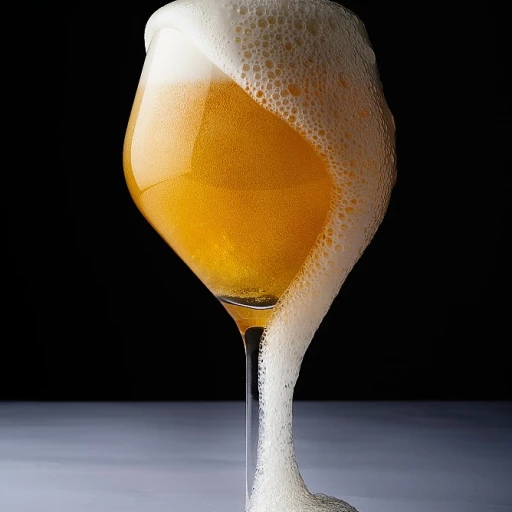
American pale ale: where hops meet refreshment
The refreshing balance of hops and malt
American pale ale (APA) stands out as a vibrant, approachable beer style that perfectly balances hop-forward flavors with a crisp, refreshing finish. Unlike heavier or more intensely bitter beers, APAs offer a harmonious blend of citrusy, piney, and floral hop notes, supported by a gentle malt backbone. This makes them a favorite for those who appreciate complexity without overwhelming bitterness.
What truly sets APAs apart is their drinkability. They are crafted to be enjoyed in a variety of settings, from backyard barbecues to craft beer bars. The moderate alcohol content and lively carbonation make them a go-to choice for both seasoned enthusiasts and newcomers to the world of craft beer.
- Bright hop aromas with subtle malt sweetness
- Clean, crisp finish that invites another sip
- Versatile pairing with food, from burgers to spicy dishes
Curious about how American pale ales compare to other popular styles, like IPAs? You might enjoy reading about a Tennessee IPA adventure to see how these styles differ in flavor and character.
The ingredients that shape american pale ale
The building blocks of flavor
American pale ale stands out thanks to its carefully chosen ingredients, each contributing to its signature balance of hop character and drinkability. Let’s break down what goes into the glass:
- Malts: Typically, pale malts form the backbone, providing a light, biscuity sweetness. Some brewers add a touch of specialty malts for subtle caramel notes, but the malt profile remains clean to let the hops shine.
- Hops: The star of the show. American varieties like Cascade, Centennial, and Amarillo are favorites, offering vibrant citrus, pine, and floral aromas. These hops deliver a refreshing bitterness without overwhelming the palate.
- Yeast: Clean-fermenting ale yeasts are used, allowing the hop and malt flavors to take center stage. The yeast profile is generally neutral, with minimal fruity esters.
- Water: The mineral content of the water can subtly influence the mouthfeel and accentuate hop crispness, though it’s often tailored to keep the beer refreshing and approachable.
Compared to other styles, especially IPAs, American pale ales use a lighter hand with hops and malt, resulting in a more balanced, sessionable beer. For those interested in exploring how hop-forward beers can differ, check out this guide to double IPAs for a deeper dive into bolder flavors.
Understanding these ingredients helps explain why American pale ale is such a crowd-pleaser, bridging the gap between classic English styles and the boldness of modern American brewing.
From english roots to american innovation
The journey from British tradition to American creativity
American pale ale (APA) owes its origins to the classic English pale ale, a style known for its balanced malt and hop character. When this style crossed the Atlantic, American brewers embraced it and began experimenting with local ingredients and brewing techniques. The result was a beer that retained the drinkability of its English predecessor but showcased a bolder, more vibrant hop profile.
What truly sets APA apart is the use of American-grown hops, such as Cascade, which impart citrusy and piney notes not found in traditional English varieties. This hop-forward approach, combined with a lighter malt backbone, gives APA its signature crispness and refreshing finish. Over time, this innovation helped shape the modern craft beer movement in the United States, inspiring countless brewers to put their own spin on the style.
Today, APA stands as a bridge between the maltier English ales and the more intensely hopped American IPAs. Its evolution highlights the creativity and adaptability of American brewers, who continue to push boundaries while respecting the roots of the style. For a deeper look at how tradition and innovation can coexist in the world of craft beverages, you might enjoy this article on heritage and experience in craft drinks.
How american pale ale compares to ipas and other styles
What sets american pale ale apart from IPAs and other beers?
American pale ale (APA) often gets compared to India pale ales (IPAs) and other beer styles, but there are clear differences that make each unique. If you’ve read about the ingredients and history of APA, you’ll notice how these factors influence its character compared to its relatives.
- Hop presence: APAs feature a noticeable hop aroma and flavor, but they are generally more balanced than IPAs. IPAs tend to be more assertive, with higher bitterness and often more intense citrus or pine notes.
- Alcohol content: APAs usually have a moderate alcohol level, making them more sessionable. IPAs, especially double or imperial versions, are often stronger and heavier.
- Malt profile: While both styles use pale malts, APAs often have a slightly more pronounced malt backbone, giving a subtle sweetness that balances the hops. IPAs focus more on hop-forward flavors, sometimes letting malt take a back seat.
- Other styles: Compared to lagers or wheat beers, APAs are hoppier and more aromatic, but less bitter and intense than most IPAs. They offer a refreshing middle ground for those exploring craft beer.
In summary, American pale ale stands out for its balance—offering hop character without overwhelming bitterness, and a drinkability that appeals to both new and seasoned beer fans.
Finding the best american pale ales today
What to look for in a great American pale ale
With so many breweries crafting their own versions, finding a standout American pale ale can be a fun adventure. Here are a few tips to help you choose a quality brew:
- Freshness matters: The hop character is central to this style, so always check packaging dates. Fresher beers will have brighter aromas and flavors.
- Balance is key: A good American pale ale should offer a refreshing balance between hop bitterness and malt sweetness. Too much of either can throw off the classic profile.
- Regional variations: Breweries across the country put their own spin on the style. West Coast versions often highlight citrus and pine, while others may lean into tropical or floral notes.
- Sessionability: Many fans appreciate the moderate alcohol content, making these beers easy to enjoy over a longer period without overwhelming the palate.
Where to find top examples
Start by exploring local breweries—many have their own flagship pale ales. You can also look for highly rated options from established names in craft beer. Don’t hesitate to ask staff at bottle shops or taprooms for their recommendations, as they often know which batches are freshest and most popular.
Enjoying your American pale ale
Once you’ve selected a few bottles or cans, try tasting them side by side. Notice the differences in aroma, color, and flavor. Pairing with food—like grilled chicken, burgers, or spicy dishes—can also highlight the beer’s refreshing qualities and hop-driven complexity.













